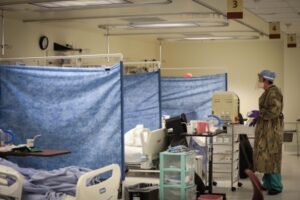
In 2021, during the COVID-19 pandemic, U.S. Navy Lt. Kathryn Hrezo, a critical-care nurse with the Rural Rapid Response Team, prepared to check patients’ blood sugar levels, while working in the COVID-19 ward at the Northern Navajo Medical Center in Shiprock, NM. Navajo leaders are asking the VA to build a medical center there to resolve healthcare shortages. U.S. Army photo by Spc. Ashunteia Smith
WASHINGTON, DC — VA has long struggled to provide care to veterans in rural areas of the country. Veterans living there are frequently required to drive long distances to VA hospitals, and smaller VA clinics are not always available.
In recent years, VA has attempted to bridge that gap by increasing access to community veterans. Yet, even non-VA care can be scarce in rural communities, where that situation is becoming even more common.
Since 2005, 105 rural hospitals have closed, and an additional 86 have been converted to outpatient-only facilities, according to the University of North Carolina Center for Health Services Research. Another 600 rural hospitals—approximately 30%—are at risk of closing in the near future, with half of those deemed in “immediate risk.”
This has legislators concerned as to whether VA can pick up the slack in these communities for veterans who might suddenly find themselves without a hospital of any kind nearby.
“While VA has an entire office dedicated to serving rural and remote veterans, I’m concerned that this office has not kept pace with the challenging veteran population,” said Rep. Mike Bost (R-IL), chairman of the House VA Committee, at a hearing on the topic last month. “We must ensure that the $311 million we have spent on this office and on the rural veteran programs are providing real value and not just lip service.”
The Government Accountability Office (GAO) has the same concerns. In May 2023, GAO issued a report that found VA’s Office of Rural Health was doing little to promote available funding to the VA researchers it was meant to be supporting. Research opportunities were communicated by word of mouth rather than any standardized practice—something VA said it hopes to address by May 2024.
GAO also found that the office had done little in the way of establishing measurable performance goals. For example, while the Office of Rural Health tracked how many rural clinicians were trained using its funding initiatives, it had not defined how many clinicians should be trained each year. GAO investigators asked what was the department’s actual goal.
VA said these metrics will be included in the office’s next strategic plan, which will be available in June.
VA officials testifying at the hearing touted a number of successes in reaching rural veterans, including significant increases in telehealth and the use of mobile medical units. But they also voiced their own distress over the impact rural hospital closures will have to veterans’ health.
“The degree of closures of critical access hospitals and critical infrastructure in rural areas is highly concerning, especially because of the disproportionate number of rural veterans that need care in our system,” declared VA Undersecretary for Health Shereef Elnahal MD. “In response, we have to invest in our direct care system. We are often the only healthcare providers for particular specialties for veterans in rural communities. We absolutely have to hire, but we also have to create more infrastructure and be able to get the appropriated funds to create that infrastructure, especially with this concerning trend of closures.”
Buu Nygren, EdD, president of the Navajo Nation, agreed, and had a concrete suggestion as to where some of that new infrastructure should be placed.
“I am respectfully requesting Congress to consider appropriating funds to build a full-service VA medical center on the Navajo Nation,” he said. “Having this center on the Nation would contribute greatly to providing the quality of care our veterans. It would also have a tremendous and positive economic impact.”
The Navajo Nation covers 27,000 square miles across three states and is home to 14,000 veterans. A veteran living in the largest community, Shiprock, NM, must drive 214 miles one way to reach the nearest VA MC in Albuquerque. Other veterans have to drive farther.
“It’s going to serve all the veterans in the area,” Nygren said. “It would benefit Navajo veterans, Hopi veterans and non-Native American veterans.”
Most of the Nation’s veteran citizens use Indian Health Service (IHS) medical care and do not know about the full range of VA benefits available to them, he added.
Asked whether he had considered a joint medical center between VA and IHS, Nygren said, “I think that would be a great idea. … Most of the concerns from the veterans is they want their treatment to be more tailored as if they showed up at a VA center instead of being just treated like a normal Native American going to that facility.”
Veterans living in the nation also tend to prefer in-person care, he added.
“A lot of these veterans are elderly. They’re Vietnam veterans and people of that age,” he said. “It’s difficult for them to travel. One of our greatest challenges is bringing [services] a lot closer to them.”

